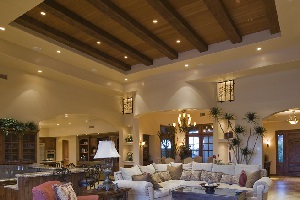While feng shui masters can often talk about how much emphasis has to be put into the “science” of geomancy, a huge part of feng shui does not talk about compass school concepts such as flying stars, 8 mansions or even bazi.
For example, form school concepts like the interior blades and bright halls don’t need any guidance from directions, numbers or mathematics to implement competently on a location.
These feng shui concepts are in fact, very basic fundamentals that need to be addressed in any land or property no matter the facing direction or sitting direction.
Another one of these basic feng shui concepts concern the relationship between the ceiling and floor of a space.
This can refer to the whole house, the living room, bedroom, etc, of any enclosed space where there is a ceiling and flooring.
3 basic rules apply when reviewing how well your ceiling matches with your flooring.
Keep in mind that when we mention flooring in this instance, it includes the shape, form and color of all furniture and fittings within the floor area in question.
1) Top bright bottom dark
This is the idea that the ceiling should always be painted in a color that is lighter than the ground.
While some can theoretically argue that a black floor with a ceiling that is 1 tone lighter than black meets the criteria of this rule, having a dark ceiling is undesirable in feng shui. A dark ceiling is also not bright.
So the practice of top bright bottom dark (上明下暗) essentially means that the upper area (ceiling) should be a light color and the lower area be of a darker color.
For example, white ceilings with maroon furniture and hardwood flooring.
If the ceiling is of a color tone as dark as the furniture and fixtures, then there is no clear distinction between the two areas.
This also implies failing to meet the second criteria of…
2) Top light bottom heavy
While it not often that we see living rooms or other living areas with more fixtures above than below, it’s not non-existent.
Some homeowners can sometimes go overboard with wall fixtures such as shelves fixed onto the walls or ceiling fans installed right on the ceilings.
There’s nothing wrong with having these fixtures and fittings. But having them dominate the furniture and fixtures on the floor of the living space would create this predicament.
The top light bottom heavy concept (上轻下重) is meant to adhere to the commonsensical building practice of having a big and strong foundational base with lighter levels above.
This is so that the bottom has a strong foothold to support what is above.
Don’t forget that the top represents heaven while the bottom represents earth. Thus, heaven has to be light so to “float” above the earth.
High ceiling houses and apartments tend to avoid this feng shui problem easily.
And if there are more lighting fixtures on the floor than on the ceiling, it can also create the effect of top heavy bottom light.
3) Top round bottom square
As mentioned in the previous point, the ceiling represents heaven and the ground represents earth.
In symbolism, heaven is represented by roundness and circles, while earth is represented by squares and right angles.
This rule (上圆下方) is something that people usually fall afoul of only when there is a combination a square ceiling and a round floor.
It would be acceptable when there is a:
- Round ceiling and round floor
- Round ceiling and square floor
- Square ceiling and square floor
But when there is a square ceiling and round floor, then it should be something that is concerning from feng shui perspective.
Some might wonder how can this interior setup be even possible?
Well, sometimes false ceilings from lightings and creative carpets can bring this configuration into the house.

Finally, it’s worth noting that a big reason for these rules of ceiling and floor combinations is to have a clear distinction between the ceiling and floor, the top and bottom area, what’s above and what’s below.
This is as important in feng shui as how essential it is to have a clear demarcation of the living room and kitchen.
If for example, when the living room cannot be distinctively identified as a different living space from the kitchen, the kitchen technically becomes the kitchen! There would be no living room!
If we are unable to clearly identify the heaven area in the house, then we would be unable to call on heaven luck as heaven is not present.















